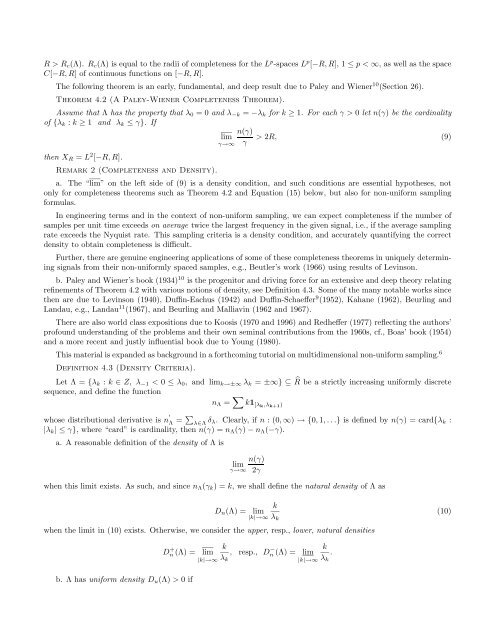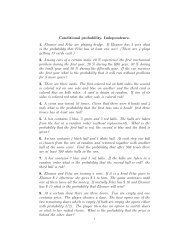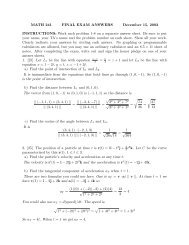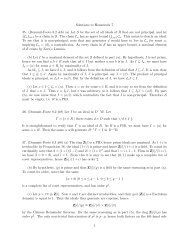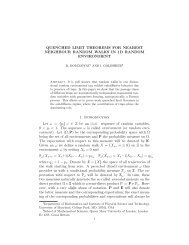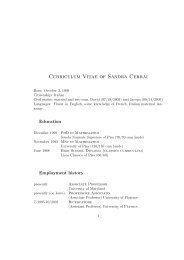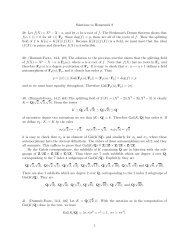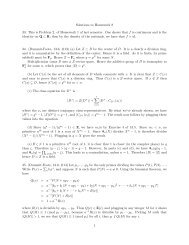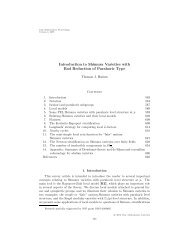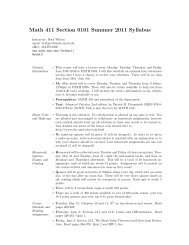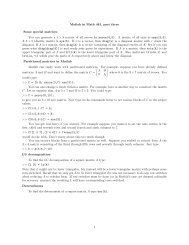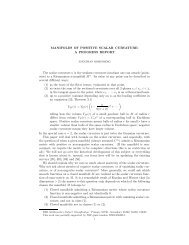Non-uniform sampling and spiral MRI reconstruction - Math ...
Non-uniform sampling and spiral MRI reconstruction - Math ...
Non-uniform sampling and spiral MRI reconstruction - Math ...
You also want an ePaper? Increase the reach of your titles
YUMPU automatically turns print PDFs into web optimized ePapers that Google loves.
R>R c (Λ). R c (Λ) is equal to the radii of completeness for the L p -spaces L p [−R, R], 1 ≤ p0 let n(γ) be the cardinalityof {λ k : k ≥ 1 <strong>and</strong> λ k ≤ γ}. Ifn(γ)lim > 2R, (9)γ→∞ γthen X R = L 2 [−R, R].Remark 2 (Completeness <strong>and</strong> Density).a. The “lim” on the left side of (9) is a density condition, <strong>and</strong> such conditions are essential hypotheses, notonly for completeness theorems such as Theorem 4.2 <strong>and</strong> Equation (15) below, but also for non-<strong>uniform</strong> <strong>sampling</strong>formulas.In engineering terms <strong>and</strong> in the context of non-<strong>uniform</strong> <strong>sampling</strong>, we can expect completeness if the number ofsamples per unit time exceeds on average twice the largest frequency in the given signal, i.e., if the average <strong>sampling</strong>rate exceeds the Nyquist rate. This <strong>sampling</strong> criteria is a density condition, <strong>and</strong> accurately quantifying the correctdensity to obtain completeness is difficult.Further, there are genuine engineering applications of some of these completeness theorems in uniquely determiningsignals from their non-<strong>uniform</strong>ly spaced samples, e.g., Beutler’s work (1966) using results of Levinson.b. Paley <strong>and</strong> Wiener’s book (1934) 10 is the progenitor <strong>and</strong> driving force for an extensive <strong>and</strong> deep theory relatingrefinements of Theorem 4.2 with various notions of density, see Definition 4.3. Some of the many notable works sincethen are due to Levinson (1940), Duffin-Eachus (1942) <strong>and</strong> Duffin-Schaeffer 9 (1952), Kahane (1962), Beurling <strong>and</strong>L<strong>and</strong>au, e.g., L<strong>and</strong>au 11 (1967), <strong>and</strong> Beurling <strong>and</strong> Malliavin (1962 <strong>and</strong> 1967).There are also world class expositions due to Koosis (1970 <strong>and</strong> 1996) <strong>and</strong> Redheffer (1977) reflecting the authors’profound underst<strong>and</strong>ing of the problems <strong>and</strong> their own seminal contributions from the 1960s, cf., Boas’ book (1954)<strong>and</strong> a more recent <strong>and</strong> justly influential book due to Young (1980).This material is exp<strong>and</strong>ed as background in a forthcoming tutorial on multidimensional non-<strong>uniform</strong> <strong>sampling</strong>. 6Definition 4.3 (Density Criteria).Let Λ = {λ k : k ∈ Z, λ −1 < 0 ≤ λ 0 , <strong>and</strong> lim k→±∞ λ k = ±∞} ⊆ ̂R be a strictly increasing <strong>uniform</strong>ly discretesequence, <strong>and</strong> define the functionn Λ = ∑ k1 [λk ,λ k+1 )whose distributional derivative is n ′ Λ = ∑ λ∈Λ δ λ. Clearly, if n :(0, ∞) →{0, 1,...} is defined by n(γ) =card{λ k :|λ k |≤γ}, where “card” is cardinality, then n(γ) =n Λ (γ) − n Λ (−γ).a. A reasonable definition of the density of Λ isn(γ)limγ→∞ 2γwhen this limit exists. As such, <strong>and</strong> since n Λ (γ k )=k, we shall define the natural density of Λ asD n (Λ) =lim|k|→∞kλ k(10)when the limit in (10) exists. Otherwise, we consider the upper, resp., lower, natural densitiesD + n (Λ) =b. Λ has <strong>uniform</strong> density D u (Λ) > 0iflim|k|→∞kλ k, resp., D − n (Λ) = lim|k|→∞kλ k.


